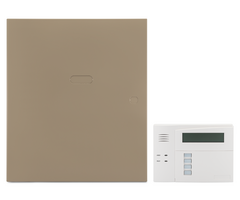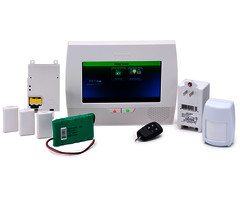Arm Away Vs. Arm Maximum
Related Products








Related Categories
- Small Business Security Systems
- Monitored Home Security Systems
- DIY Wireless Security Systems
- DIY Wired Security Systems
- Apartment Security Systems
Description
In this video, Jarrett talks about the difference between Arm Away and Arm Maximum modes. These are basically the same arming types, but there is one important difference. The difference is that Arm Maximum mode ignores any Entry Delays. For that reason, Arm Max is a more secure version of Arm Away.
Arm Away mode is one of the most common arming types used with alarm systems. This is the mode you will normally use when you arm your system and there is supposed to be nobody inside the building. In Arm Away mode, activating a Perimeter zone will cause an immediate system alarm. The same is true if you activate an Interior Follower zone without activating an Entry/Exit zone first. If you activate an Entry/Exit zone, you can Disarm the system within the Entry Delay period before an alarm occurs.
Arm Maximum behaves the same as Arm Away, except that there are no Entry Delay periods. In other words, if you activate an Entry/Exit zone while the system is Armed Maximum, you will not get an Entry Delay period to Disarm the system. Instead, the system will just go into immediate alarm. If you are outside the building and your system is Armed Maximum, then you will need to find a way to Disarm without activating an intrusion zone. In most cases, the only ways to do that are by using a key fob or by using an interactive alarm monitoring platform like Total Connect 2.0 or Alarm.com.
Armed Maximum is considered the most secure arming mode available. It is the only arming mode that tells the system to ignore Entry Delays and just trigger an immediate alarm when Entry/Exit zones are activated. You should not confuse either Arm Away or Arm Maximum with Arm Stay and Night Stay. Arm Stay will automatically bypass Interior zones so that people can move throughout the building freely. If you activate an Entry/Exit zone in Stay mode, then you will need to Disarm within the Entry Delay period, or an alarm will occur. Night Stay is the same as Arm Stay, except that the system will not bypass interior sensors enabled for Night mode. Night Stay is good to use if you want certain Interior zones to be active, while others are automatically bypassed.
http://alrm.gd/get-monitored
Transcript
Hey, DIYers. Jarrett with Alarm Grid here. Today we're going to be discussing the difference between Armed Away and Armed Away Max mode. Now, Armed Away mode is normally, commonly used because when you put the system in Armed Away Mode, there's what's called an Entry Delay period. And what an Entry Delay period is that if you were to fault an entry/exit zone, it's the time period that the system gives you to be able to disarm the system before the alarm is set off. Now, if you were to put the system on Armed Away Max mode, it's a bit different than Armed Away because it doesn't-- or it actually completely ignores any Entry Delay period set that you have for the system. So, basically, meaning if you were to fault any entry/exit zones, be it a front door, back door, patio door, or anything that you have it set for that, it's going to immediately set off your alarm. Now, normally people use this mode whenever they're out of town, or they're on vacation. And they're not expecting any company to come over, whether it be any house sitters or anything like that. And they want to be immediately notified if anything were to happen to the system or any zones were to be tripped, or anything like that. Now, if you are using the system into an Armed Away, or if you are using Armed Away Max, we normally do recommend that you at least have a key fob or Total Connect 2.0 to be able to disarm the system before you go into the home or the building. So that you make sure you're not tripping that alarm, and you don't have any type of false alarms, or anything like that. Now, there are a couple of systems out there that do not have the option to be able to put the system to an Armed Away Max mode. But there are some settings that you can change in the system to be able to enable that option, or mimic the Armed Away Max mode. Now, the Honeywell Lyric, for instance, it actually does not have the Arm Away Max mode programmed into it. But we can change the settings to do so or mimic it. Now, really, changing the settings for it is just turning off the Entry Delay period and then putting the system-- or going into an Armed Away mode. And that is, basically, mimicking the settings for Armed Away Max. Now, there's two ways you can go about changing the settings. You can go into the system programming of the panel and completely turn off the Entry Delay period, completely. Or you can go into-- or there's a more simpler way of doing so. And you can go into the area where you would normally arm the system, and you can turn off the Entry Delay period right there. So I'm actually going to show you how to change the setting real quick and put the system to an Armed Away Max mode. So if you're looking at the Lyric-- right now, if you were at this main menu or this main screen, to get to the area where you would arm the system, you would just press Security. [BEEP] And as you'll see, you have Arm Away, Arm Stay, or Arm Custom, everything. If you look at the bottom left, you'll see the option for Entry Delay. If you just simply tap on that, it will turn off the Entry Delay, and you're already mimicking the settings for Armed Away Max. So what you'll do next is just press Arm Away. You'll type in your master code to arm the system. [BEEPING] So, as you can see, the system did go into an Armed Away Instant mode, which is basically Armed Away Max. So if I were to fault an entry/exit zone whatsoever, it's going to immediately set off the alarm. All right. So right now what we have is a sensor program, it's an entry/exit zone into the Honeywell Lyric System. And this program has front door. So what I'm going to be doing real quick is just putting the system to an Armed Away Mode, and we're going to fault the sensor. I'm going to show you that Entry Delay period that you normally get with Arm Away mode. And then I'm going to put the system to an Armed Away Maximum, so that I can then fault the sensor. And then you'll see that the alarm will immediately trip. So what we're going to do-- let's go to Security. And then to Arm Away, or to arm the system away, what you're going to do is just tap Arm Away. And you type in your master code, which is 1, 2, 3, 4. [BEEPING] Armed Away, exit now. [HIGH-PITCHED BEEPING] Armed Away, disarm system now. [HIGH-PITCHED BEEPING] I guess it had already-- Disarmed. [INTERPOSING VOICES] --faulted the door contact, by accident. But when I did fault the door-- Front door. When I did fault the door contact, as you can see, it did give you the Exit Delay Period or the Entry Delay Period as you would whenever you would-- Front door. --open your front door, when the system is in an Armed Away mode. Now, what we're going to do is-- to go into the Arm Maximum mode, as I did explain, we're going to turn off the entry delay. And then we're going to arm the system to an Armed Away mode. [BEEPING] Armed away. Instant, exit now. [HIGH PITCHED BEEPING] Armed away. Instant. OK. So, as we already know, the system is in Armed Away Instant mode. And once I fault the sensor, you'll see that the alarm is going to go off immediately. [CONTINUOUS BEEP] [BEEPING] Disarmed. Not ready to arm. Check zone. [BEEPING] Disarmed. Ready to arm. [INAUDIBLE] So, as you can see, the alarm did go off immediately when the system is placed into an Armed Maximum mode. So, as you can see, now we have the Honeywell VISTA System. And the Honeywell VISTA panels actually do have the option to go into an Armed Away Max mode. You don't have to change any of the settings with the Entry Delay Period, at all. You already have that programmed to the system. So to put your VISTA System to an Armed Away Max mode, you're just going to type in the master code, followed by the number 4. So, now, as you can see, we have the keypad up and going right here. So what I'm actually going to do is put the system into an Armed Away mode first, so that you can see exactly what that sounds like and everything. And then I'm going to put the system in Armed Away Maxed mode, and you'll see the difference between the two. So to put the system in Armed Away mode, you're just going to type the master code, followed by the number 2. [BEEPING] Armed Away. Exit now. [BEEPING] So, as you can see, right now it just says-- Disarmed. Ready to arm. The system is set to an Armed Away, and, obviously, the Exit Now. So now I'm going to put the system Armed Away Max Mode, and you will see and hear the difference between the two. [BEEPING] Armed away. Instant. Exit now. [BEEPING] Disarmed. Ready to arm. OK. So, as you can see, the Honeywell VISTA System was able to go into an Armed Away Max mode. It did say Armed Away Instant. And you also were able to see the Entry or the Exit Delay, as well. So if you were to be putting the system into an Armed Away Max mode, you don't have to worry about that. You will have time to be able to leave the building. So that is the difference between Armed Away and Armed Away Max. If you have any questions about arming the alarm system or alarm systems in general, please contact us at support@alarmgrid.com or go to our website, alarmgrid.com. If you've found this video helpful, please Like or subscribe. For notifications of future videos, please click the bell icon. This is Jarrett with Alarm Grid. You have yourself a great day.
- Uploaded



